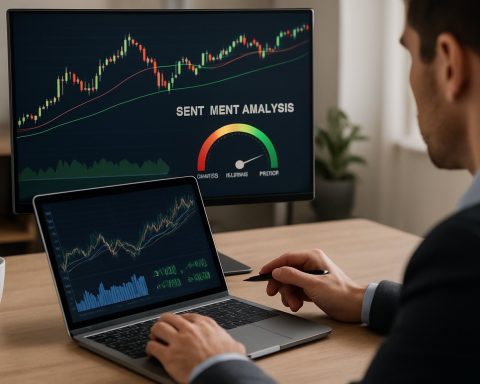Sentiment Analysis for Algorithmic Trading in 2025: Market Dynamics, AI Innovations, and Strategic Forecasts. Explore Growth Drivers, Regional Leaders, and Competitive Insights Shaping the Next 5 Years.
- Executive Summary & Market Overview
- Key Technology Trends in Sentiment Analysis for Algorithmic Trading
- Competitive Landscape and Leading Players
- Market Growth Forecasts (2025–2030): CAGR, Revenue, and Adoption Rates
- Regional Analysis: North America, Europe, Asia-Pacific, and Emerging Markets
- Future Outlook: Innovations, Regulatory Impacts, and Market Evolution
- Challenges and Opportunities: Data Quality, Model Accuracy, and Integration Strategies
- Sources & References
Executive Summary & Market Overview
Sentiment analysis for algorithmic trading refers to the use of natural language processing (NLP) and machine learning techniques to extract, quantify, and interpret market sentiment from unstructured data sources—such as news articles, social media, financial reports, and analyst commentary—to inform and automate trading decisions. In 2025, this market segment is experiencing robust growth, driven by the increasing volume of digital content, advancements in AI, and the demand for alternative data in quantitative trading strategies.
The global sentiment analysis market for financial applications is projected to reach USD 6.5 billion by 2025, growing at a CAGR of over 14% from 2022, according to MarketsandMarkets. Within algorithmic trading, sentiment analysis is being rapidly adopted by hedge funds, proprietary trading firms, and asset managers seeking to gain an informational edge. The proliferation of real-time data feeds and the integration of sentiment signals into trading algorithms have enabled faster and more nuanced responses to market-moving events.
Key drivers include the increasing sophistication of NLP models, such as transformer-based architectures, which can process and contextualize large volumes of text with high accuracy. Major financial data providers, including Refinitiv and Bloomberg, have expanded their sentiment analytics offerings, providing structured sentiment scores and event-driven signals that can be directly integrated into trading systems. Additionally, specialized vendors like RavenPack and Amenity Analytics are delivering granular sentiment data tailored for quantitative strategies.
The competitive landscape is marked by increasing collaboration between fintech startups and established financial institutions, as well as ongoing investment in AI research. Regulatory scrutiny around the use of alternative data and AI-driven trading models is also shaping market practices, with firms focusing on transparency and explainability in their sentiment models.
In summary, sentiment analysis is becoming a core component of algorithmic trading in 2025, offering the potential for alpha generation, risk mitigation, and improved market timing. As the technology matures and data sources diversify, its adoption is expected to deepen across asset classes and trading styles, reinforcing its strategic importance in the evolving landscape of quantitative finance.
Key Technology Trends in Sentiment Analysis for Algorithmic Trading
Sentiment analysis for algorithmic trading leverages natural language processing (NLP), machine learning, and big data analytics to extract actionable insights from unstructured textual data—such as news articles, social media posts, and financial reports—to inform trading strategies. In 2025, several key technology trends are shaping the evolution and adoption of sentiment analysis in algorithmic trading.
- Advanced NLP Models: The integration of large language models (LLMs) and transformer-based architectures, such as OpenAI’s GPT-4 and Google’s BERT, has significantly improved the accuracy and contextual understanding of sentiment analysis tools. These models can process vast volumes of financial text in real time, capturing nuanced sentiment shifts that traditional models might miss. Financial institutions are increasingly deploying these models to gain a competitive edge in high-frequency trading (Nasdaq).
- Multimodal Data Fusion: Traders are moving beyond text-only sentiment analysis by incorporating data from images, audio, and video. For example, analyzing CEO tone in earnings calls or visual cues from financial news broadcasts can provide additional sentiment signals. This multimodal approach enhances the robustness of trading algorithms (McKinsey & Company).
- Real-Time Processing and Edge Computing: The demand for ultra-low-latency trading has driven the adoption of edge computing and real-time data pipelines. Firms are deploying sentiment analysis models closer to data sources, reducing processing times and enabling faster trade execution based on breaking news or social media trends (Gartner).
- Explainable AI (XAI): Regulatory scrutiny and the need for transparency have led to the rise of explainable sentiment analysis models. These models provide clear rationales for trading decisions, helping firms comply with evolving financial regulations and build trust with stakeholders (Deloitte).
- Alternative Data Integration: The use of alternative data sources—such as satellite imagery, web traffic, and geolocation data—combined with sentiment analysis is becoming mainstream. This integration allows for more comprehensive market sentiment assessments and predictive trading signals (Refinitiv).
These technology trends are collectively enhancing the precision, speed, and transparency of sentiment-driven algorithmic trading, positioning it as a critical tool for institutional and quantitative investors in 2025.
Competitive Landscape and Leading Players
The competitive landscape for sentiment analysis in algorithmic trading is rapidly evolving, driven by advancements in natural language processing (NLP), machine learning, and the increasing availability of alternative data sources. As of 2025, the market is characterized by a mix of established financial technology firms, specialized sentiment analytics providers, and major cloud service companies integrating sentiment modules into their platforms.
Key players in this space include Refinitiv, which offers sophisticated sentiment analysis tools as part of its data feeds, enabling institutional clients to incorporate real-time news and social media sentiment into trading strategies. Bloomberg has also expanded its sentiment analytics capabilities, leveraging its vast news and data infrastructure to provide actionable sentiment scores for equities, commodities, and currencies.
Specialized providers such as RavenPack and Accern have carved out significant market share by focusing exclusively on AI-driven sentiment analytics. These firms differentiate themselves through proprietary NLP models trained on financial text, offering granular sentiment signals that can be directly integrated into algorithmic trading systems. Sentifi is another notable player, utilizing crowd-sourced data and AI to deliver real-time sentiment insights, particularly valued by hedge funds and asset managers seeking an edge in high-frequency trading.
Cloud service providers such as Google Cloud and Microsoft Azure have entered the market by offering scalable sentiment analysis APIs, allowing trading firms to build custom solutions or augment existing models with cloud-based NLP capabilities. These platforms are increasingly favored by quantitative trading firms for their flexibility and integration with big data analytics pipelines.
The competitive environment is further intensified by the entry of alternative data aggregators like Quandl and AlphaSense, which provide access to a wide array of sentiment data sources, including earnings call transcripts, regulatory filings, and social media feeds. This proliferation of data and analytics options is pushing firms to differentiate on the basis of data quality, model transparency, and the speed at which sentiment signals can be delivered to trading algorithms.
Overall, the sentiment analysis for algorithmic trading market in 2025 is marked by robust competition, rapid innovation, and a growing emphasis on real-time, explainable AI solutions tailored to the needs of institutional investors and quantitative trading firms.
Market Growth Forecasts (2025–2030): CAGR, Revenue, and Adoption Rates
The market for sentiment analysis solutions in algorithmic trading is poised for robust growth between 2025 and 2030, driven by increasing demand for real-time data analytics and the proliferation of alternative data sources. According to projections by MarketsandMarkets, the global sentiment analytics market is expected to achieve a compound annual growth rate (CAGR) of approximately 15% during this period, with the financial services sector—particularly algorithmic trading—representing a significant share of this expansion.
Revenue generated from sentiment analysis tools tailored for algorithmic trading is forecasted to surpass $2.5 billion by 2030, up from an estimated $1.1 billion in 2025. This surge is attributed to the growing integration of natural language processing (NLP) and machine learning models into trading platforms, enabling traders and institutional investors to extract actionable insights from news, social media, and financial reports in real time. Grand View Research highlights that the adoption rate of sentiment analysis in trading strategies is expected to reach 45% among quantitative hedge funds and proprietary trading firms by 2030, compared to just 28% in 2025.
- North America is projected to maintain its dominance, accounting for over 40% of global revenue, fueled by the presence of major financial institutions and technology providers such as Bloomberg and Refinitiv.
- Asia-Pacific is anticipated to exhibit the fastest CAGR, exceeding 17%, as regional exchanges and asset managers increasingly adopt AI-driven trading solutions.
- Cloud-based sentiment analysis platforms are expected to outpace on-premises solutions, with a CAGR of 18%, due to scalability and ease of integration with existing trading infrastructure.
Key drivers behind these forecasts include regulatory encouragement for transparency, the competitive advantage conferred by faster and more accurate market sentiment detection, and the expanding universe of unstructured data sources. As a result, the period from 2025 to 2030 is set to witness accelerated adoption and revenue growth for sentiment analysis technologies within the algorithmic trading ecosystem.
Regional Analysis: North America, Europe, Asia-Pacific, and Emerging Markets
The global landscape for sentiment analysis in algorithmic trading is marked by distinct regional dynamics, shaped by regulatory environments, technological adoption, and market maturity. In 2025, North America, Europe, Asia-Pacific, and emerging markets each present unique opportunities and challenges for the deployment and growth of sentiment-driven trading strategies.
- North America: The United States remains the epicenter for sentiment analysis in algorithmic trading, driven by the presence of major financial institutions, advanced AI research, and a robust fintech ecosystem. The adoption of alternative data, including social media and news sentiment, is widespread among hedge funds and proprietary trading firms. Regulatory clarity from the U.S. Securities and Exchange Commission and the Financial Industry Regulatory Authority has fostered innovation while ensuring market integrity. According to Grand View Research, North America accounted for over 40% of the global algorithmic trading market share in 2024, with sentiment analysis tools being a key differentiator for competitive trading strategies.
- Europe: European markets are characterized by a strong regulatory framework, particularly under the European Securities and Markets Authority (ESMA) and MiFID II directives, which emphasize transparency and investor protection. While this has slowed the pace of innovation compared to North America, it has also led to the development of highly reliable and compliant sentiment analysis solutions. The UK, Germany, and France are leading adopters, with London serving as a hub for fintech startups specializing in natural language processing (NLP) and sentiment analytics. MarketsandMarkets projects steady growth in the region, driven by increased demand for risk management and compliance-focused sentiment tools.
- Asia-Pacific: The Asia-Pacific region is experiencing rapid growth, fueled by expanding capital markets in China, Japan, and India. The proliferation of retail trading platforms and mobile-first investment apps has accelerated the integration of real-time sentiment analysis. Regulatory bodies such as the Hong Kong Securities and Futures Commission and Securities and Exchange Board of India are increasingly supportive of fintech innovation, provided it aligns with investor protection mandates. According to Fortune Business Insights, Asia-Pacific is expected to register the highest CAGR in the algorithmic trading market through 2025, with sentiment analysis as a core growth driver.
- Emerging Markets: In Latin America, the Middle East, and Africa, adoption of sentiment analysis for algorithmic trading is nascent but growing. Market participants are leveraging cloud-based analytics and open-source NLP tools to overcome infrastructure limitations. Regulatory frameworks are evolving, with countries like Brazil and South Africa making strides in capital market modernization. IDC notes that partnerships with global fintech providers are accelerating technology transfer and skill development in these regions, setting the stage for future growth.
Future Outlook: Innovations, Regulatory Impacts, and Market Evolution
Looking ahead to 2025, sentiment analysis for algorithmic trading is poised for significant transformation, driven by technological innovation, evolving regulatory frameworks, and shifting market dynamics. The integration of advanced natural language processing (NLP) models, particularly those leveraging large language models (LLMs), is expected to enhance the granularity and accuracy of sentiment signals extracted from diverse data sources, including social media, news feeds, and financial disclosures. Firms such as Refinitiv and Bloomberg are already expanding their sentiment analytics offerings, incorporating real-time, multilingual, and context-aware capabilities to better inform trading algorithms.
On the innovation front, the adoption of multimodal sentiment analysis—combining text, audio, and even video data—is anticipated to provide a more holistic view of market sentiment. This is particularly relevant as retail investor influence grows and alternative data sources proliferate. The use of explainable AI (XAI) in sentiment models is also gaining traction, addressing the need for transparency in algorithmic decision-making and facilitating compliance with emerging regulations.
Regulatory impacts are expected to intensify in 2025, as global authorities scrutinize the use of AI and alternative data in financial markets. The U.S. Securities and Exchange Commission (SEC) and the European Securities and Markets Authority (ESMA) are both considering frameworks that would require greater disclosure of algorithmic trading strategies and the data sources underpinning them. These measures aim to mitigate risks related to market manipulation, data privacy, and systemic bias, compelling market participants to adopt more robust governance and validation processes for sentiment-driven models.
- Market Evolution: The global sentiment analytics market for financial services is projected to grow at a CAGR exceeding 15% through 2025, according to MarketsandMarkets. This growth is fueled by increased demand for real-time insights and the competitive advantage conferred by sophisticated sentiment-driven trading strategies.
- Industry Collaboration: Partnerships between fintechs, data providers, and academic institutions are accelerating the development of proprietary sentiment indices and benchmarks, as seen in initiatives by Thomson Reuters and leading quantitative hedge funds.
- Challenges: Despite advancements, challenges remain in filtering noise, managing data quality, and adapting to rapidly changing market narratives—issues that will shape the next wave of innovation and regulatory focus.
In summary, 2025 will mark a pivotal year for sentiment analysis in algorithmic trading, characterized by technological breakthroughs, heightened regulatory oversight, and a maturing market landscape that rewards transparency, adaptability, and data-driven precision.
Challenges and Opportunities: Data Quality, Model Accuracy, and Integration Strategies
Sentiment analysis has become a cornerstone of algorithmic trading, enabling firms to extract actionable insights from vast streams of unstructured data such as news articles, social media, and financial reports. However, the deployment of sentiment analysis in trading strategies faces significant challenges related to data quality, model accuracy, and integration with existing trading systems, while also presenting unique opportunities for differentiation and alpha generation.
Data Quality Challenges and Opportunities
The effectiveness of sentiment analysis models is highly dependent on the quality and relevance of input data. Financial markets are influenced by a multitude of sources, and the proliferation of social media has introduced both valuable signals and substantial noise. Ensuring data integrity—by filtering out spam, misinformation, and irrelevant content—remains a persistent challenge. Moreover, language nuances, sarcasm, and regional dialects can distort sentiment signals, leading to potential misinterpretations. However, advances in natural language processing (NLP) and the use of curated data feeds from providers such as Refinitiv and Bloomberg offer opportunities to enhance data quality through rigorous vetting and real-time validation.
Model Accuracy: Limitations and Advances
Model accuracy is another critical concern. Sentiment models trained on general datasets may underperform in the financial domain due to the specialized language and context of market news. The risk of overfitting, where models capture noise rather than true market-moving sentiment, is significant. Recent advances in domain-specific large language models (LLMs) and transfer learning have improved accuracy, as evidenced by research from J.P. Morgan and Goldman Sachs. These institutions are leveraging proprietary datasets and fine-tuning models to better capture financial sentiment, thus reducing false positives and improving predictive power.
- Integration Strategies: Integrating sentiment analysis into algorithmic trading systems requires robust data pipelines, low-latency processing, and seamless interoperability with order management systems. Firms are increasingly adopting cloud-based analytics platforms from providers like Google Cloud and Microsoft Azure to scale sentiment analysis and ensure real-time execution. The use of APIs and microservices architectures facilitates modular integration, allowing for rapid deployment and iterative improvements.
In 2025, the firms that successfully address these challenges—by investing in high-quality data, domain-specific model development, and agile integration—are poised to unlock significant opportunities for alpha generation and risk mitigation in increasingly complex and information-driven markets.
Sources & References
- MarketsandMarkets
- RavenPack
- Amenity Analytics
- McKinsey & Company
- Deloitte
- Accern
- Sentifi
- Google Cloud
- Quandl
- AlphaSense
- Grand View Research
- Financial Industry Regulatory Authority
- European Securities and Markets Authority
- Hong Kong Securities and Futures Commission
- Securities and Exchange Board of India
- Fortune Business Insights
- IDC
- Thomson Reuters
- J.P. Morgan
- Goldman Sachs









